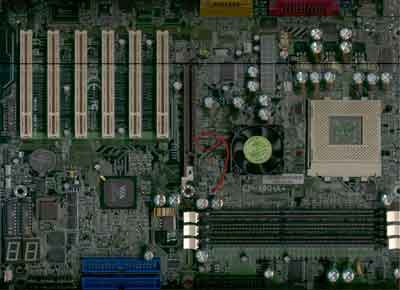VIA KT266A Motherboard Roundup - January 2002
by Mike Andrawes on January 18, 2002 4:48 AM EST- Posted in
- Motherboards
EPoX EP-8KHA+
|
EPoX EP-8KHA+ |
|
|
CPU
Interface
|
Socket-A
|
|
Chipset
|
VT8366A
North Bridge
VT8233 South Bridge |
|
Form
Factor
|
ATX
|
|
Bus
Speeds
|
100
- 210MHz (in 1MHz increments)
|
|
Core
Voltages Supported
|
-0.100
/ -0.075 / -0.050 / -0.025 /
+0.025 / +0.050 / +0.075 / +0.100 |
|
I/O
Voltages Supported
|
+0.1
/ +0.2 / +0.3 / +0.4 / +0.5 / +0.6 / +0.7
|
|
DRAM
Voltages Supported
|
Not
Configurable
|
|
Memory
Slots
|
3
184-pin DDR DIMM Slots
|
|
Expansion
Slots
|
1
AGP Slot
6 PCI Slots |
|
Onboard
RAID
|
N/A
|
|
Onboard
USB 2.0/IEEE-1394
|
N/A
|
|
Onboard
Audio
|
Avance
Logic ALC201A AC97 CODEC
|
EPoX came out with the 8KHA+ with only one competitor in mind - ABIT. Before the release of the ABIT KR7-RAID, the EPoX was one of the best KT266A boards out there, providing possibly the best overclocking ability and also stability.
Shortly after the KR7-RAID hit the market, EPoX started to leak out a beta BIOS, which is the one that we used for our roundup. The BIOS is not officially under the EPoX web page but you can easily find it floating on the Internet.
The BIOS, with release date 11/30/2001, provides the ability for you to practically push the FSB of the board to over 200MHz, which has been confirmed by a lot of sources. This is made possible by two very important features by EPoX, the 1/5 and 1/6 PCI bus divider and also the 100/133 memory bus divider. With these two settings, you can be running your FSB at 200MHz while maintaining the memory and PCI buses at 150MHz and 33MHz respectively. The memory could be compensated by the new PC2400 or PC2700 parts, and the PCI bus is still within spec.
However, we could only achieve as high as 185MHz in our test labs before the system lost its stability. Although it was still far from the 200MHz mark, it's already one of the highest FSB speeds achieved, and it's also a good indication that 200MHz FSB systems are not that far away.
Unfortunately, high speed overclocking could also come in a big price. During our overclocking test we actually corrupted one of our Western Digital hard drive at around 190MHz, resulting in a loss of all the data on the hard drive. This could be disastrous if you contain valuable information on your hard drive. Therefore, make sure you perform overclocking with caution at all times.
There are plenty of voltage settings available for both the CPU core and the DDR memory, which makes overclocking even more interesting. But just like the ASUS A7V266-E, we also noticed that the EP-8KHA+ is running the CPU at 0.05V over all the time, so you have to careful on the CPU cooling as well. The board also has the hexadecimal indicator showing the status of the system during boot-up, so you can find out what's wrong with the system if it doesn't boot up correctly.
The board also has 6 PCI slots, where ABIT is the only other company that achieved this design. 2 sets of extra USB connectors are available for 4 more USB devices, and EPoX includes header for one set of connector.
During our initial roundup, the board suffered severe compatibility issues with the NVIDIA GeForce3 Ti500 video cards, but the problem has been solved with the recent BIOS update. We now have no problem installing Windows 2000 using the Ti500.
However, our biggest complain against the EP-8KHA+ is the lack of 4 DDR DIMM slots and onboard IDE RAID controller. With these two features EPoX would be able to raise themselves even higher. Fortunately, EPoX seems to listen to all the enthusiasts out there, and they will be releasing an updated version of the EP-8KHA+ soon. The new board, named EP-8KHA2, will have 4 DIMM slots and the new Highpoint HPT372 IDE RAID controller. If the board can maintain high stability with all 4 DIMMs populated, it would be in a really close game with the ABIT KR7-RAID.











3 Comments
View All Comments
Anonymous User - Monday, September 29, 2003 - link
How do I get my Engine to Memory clock to run synchronous for my Epox 8kha+ boardxrror - Saturday, August 14, 2021 - link
This was such an exciting time in PC hardware. Intel was still trying to cram Rambus down the industry's throat - and obstinately trying to strong arm the mobo makers and force chipset makers to Rambus licensing. We still had VIA, SiS, ULi, and even nVidia in the chipset market, and with AMD's Athlon line still extraordinarily competitive and Intel in full attack they could no longer just consider AMD as a side-show - this was their leverage against Intel and they had to treat Socket A as premium platform.NegativeROG - Wednesday, June 15, 2022 - link
I still have this board. AND, I invested all of a $10,000 inheritance in Rambus RDRAM. I'm smarter now (I hope). But, you are right about exciting times in the PC space. I navigated away from AMD for a bit, but came back, and will stay forever. Team RED!